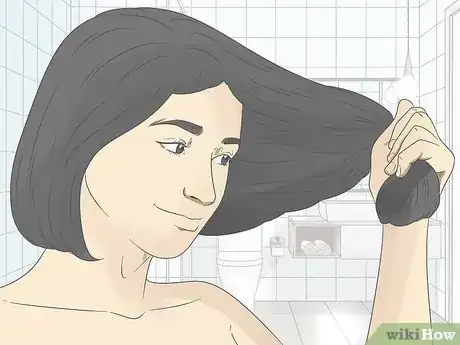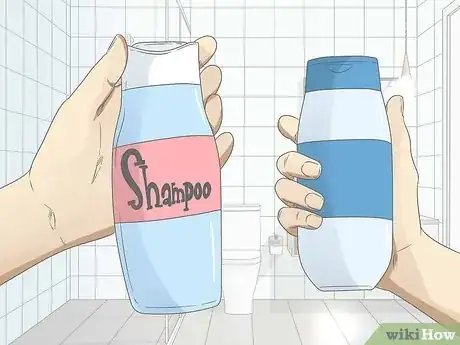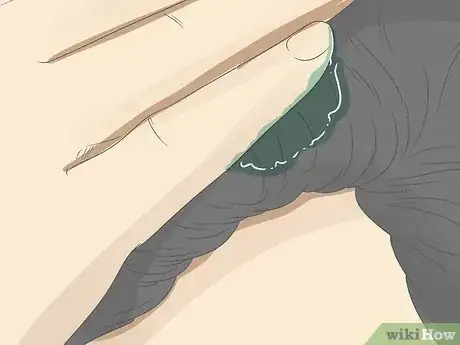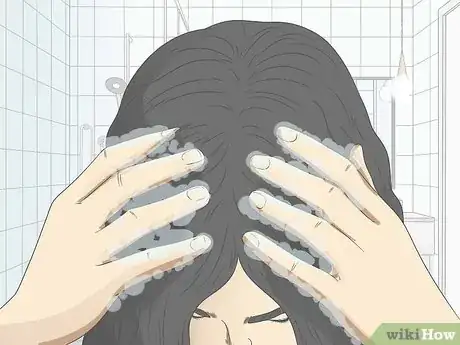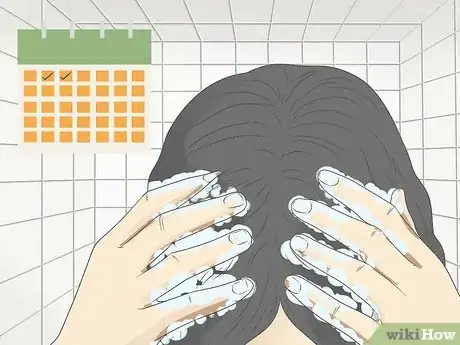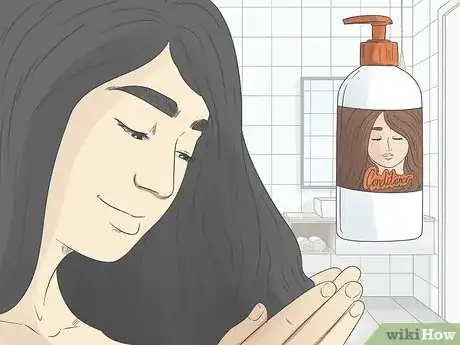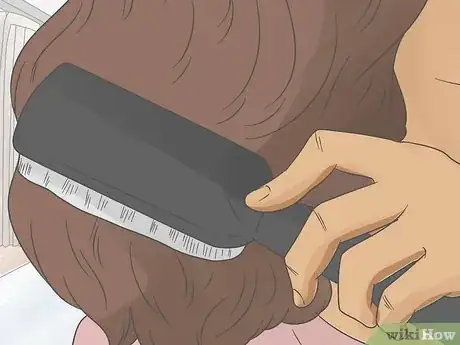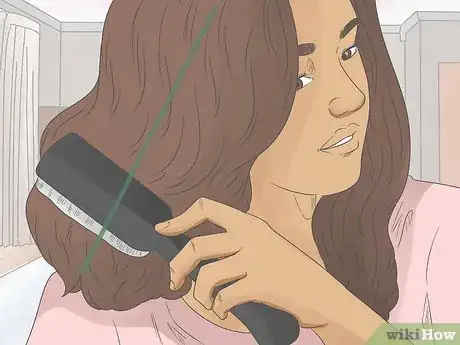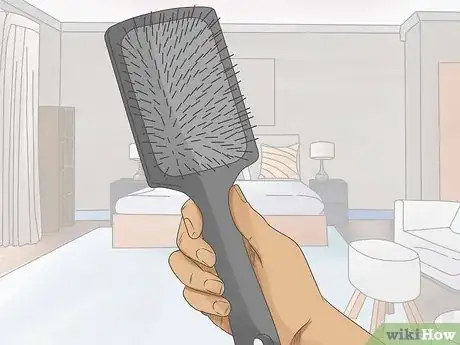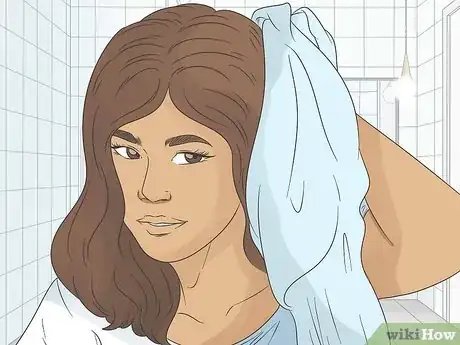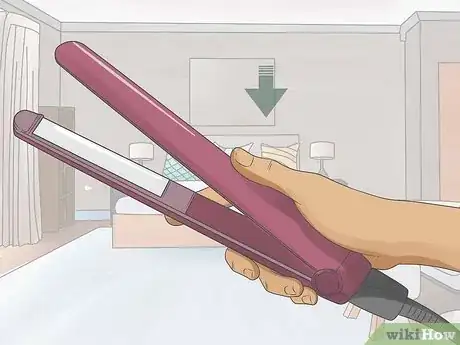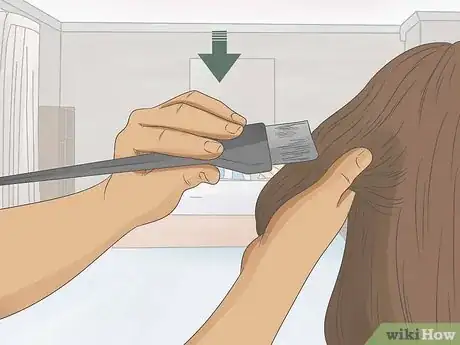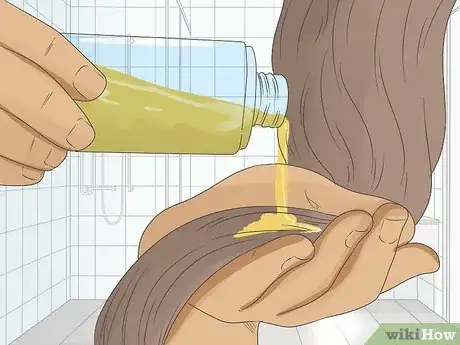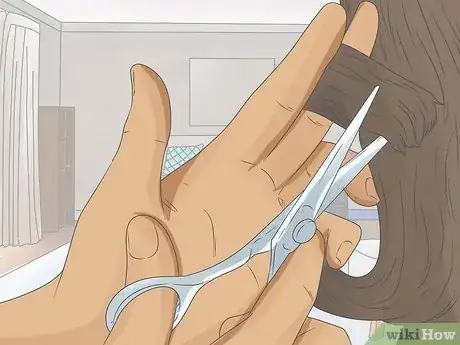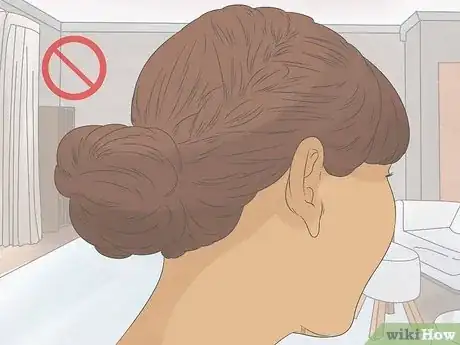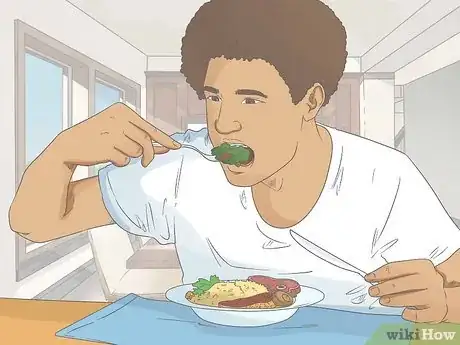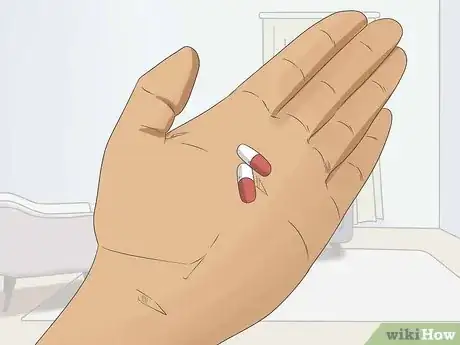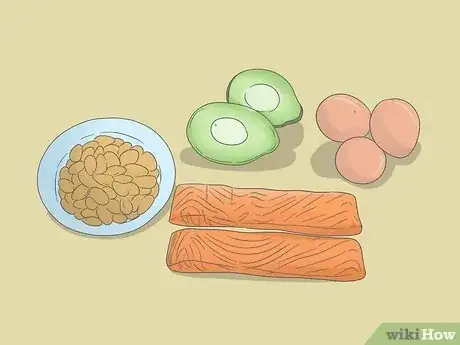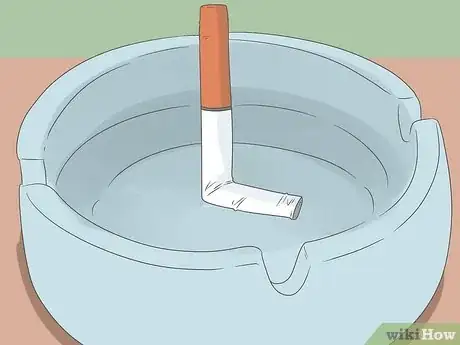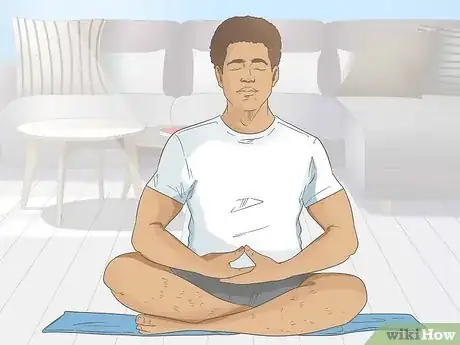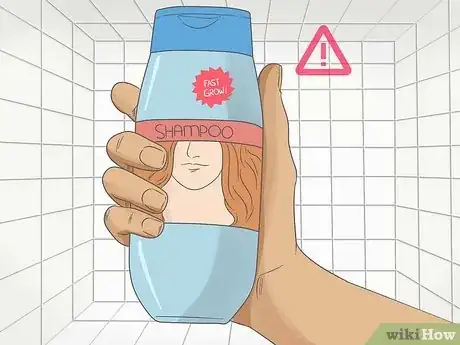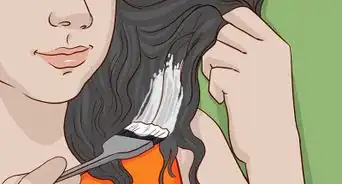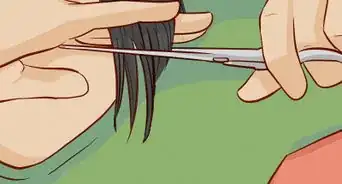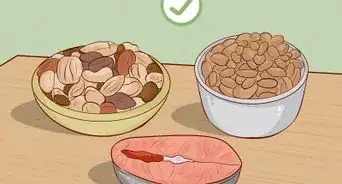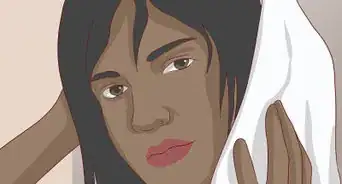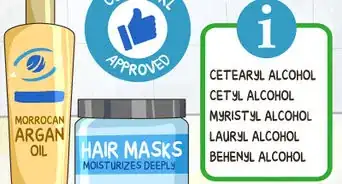This article was co-authored by Christine George. Christine George is a Master Hairstylist, Colorist, and Owner of Luxe Parlour, a premier boutique salon based in the Los Angeles, California area. Christine has over 23 years of hair styling and coloring experience. She specializes in customized haircuts, premium color services, balayage expertise, classic highlights, and color correction. She received her cosmetology degree from the Newberry School of Beauty.
There are 24 references cited in this article, which can be found at the bottom of the page.
wikiHow marks an article as reader-approved once it receives enough positive feedback. This article received 14 testimonials and 100% of readers who voted found it helpful, earning it our reader-approved status.
This article has been viewed 827,264 times.
Are you pining for long, lustrous locks? The first thing you'll need is patience: hair grows about 6 inches (15 cm) per year, or an average of 1/2 inch (1.25 cm) per month, and there is little we can do to speed up this process.[1] That said, you can protect your hair by getting the right nutrition and minimizing damage. Many elements of routine styling can actually be stressful for the hair: shampooing, heat styling, coloring, diet, stress, medications, and even brushing the wrong way all have the potential to do more harm than good.[2] With the right care, however, your hair can grow out healthy and strong.
Steps
Washing Your Hair Gently and Effectively
-
1Determine your hair type. This may depend on your hair's thickness, chemical processes you've used, and/or your scalp condition.
- Fine hair is characterized by a small diameter of the individual hairs. This hair tends to fall flat and may be more difficult to style. It also may be more susceptible to damage from styling and chemical processes.
- Thin hair is hair that has a lower density per square inch. While these hairs may or may not be fine, thin hair has many of the styling issues that fine hair has.[3]
- Thick hair, by contrast, has a higher density per square inch. No matter whether it's straight, wavy, or curly, thick hair tends to be drier than fine hair and requires daily moisturization.[4]
- There is a wide range of types of curly hair, from tight kinks to loose waves. The important thing to know about curly hair when choosing products is that it tends to be drier than straight hair.
- Color-treated hair has been dyed using chemical processes. Dyes strip the protective outer layer of lipids from hair, leaving it vulnerable to damage. Products designed for this kind of hair are meant to protect it and keep heat and water from leaching your color.[5]
- Dry hair is usually the result of over-processing, be it coloring, heat-styling, or overuse of products containing alcohol. It is fragile, so tends to break easily.
- Oily hair usually refers to oily scalp. Hair may be difficult to clean, feel greasy, or have an unpleasant smell. Dandruff also results from an oily scalp. This can be due to a number of factors, including hormones, vitamin deficiencies, and heredity. Ironically, it could also be that your scalp was dry–and the body, in compensation, is now overproducing oil.[6]
-
2Choose shampoo and conditioner for your hair type. Hair types include normal, fine, dry, oily, color-treated, and dandruff.[7]
- Fine and thin hair may benefit from products labeled "volumizing," which boosts body.[8]
- For thick and/or curly hair, avoid products with sulfates in them (ammonium laureth sulfate, ammonium lauryl sulfate, sodium laureth sulfate, sodium lauryl sulfate). These are detergents that can strip curly hair of its moisture and leave it frizzy.[9]
- For dry hair, look for moisturizing ingredients, especially natural oils like coconut, argan, avocado, jojoba, and grapeseed. Stay away from products containing alcohol.[10] [11]
- Color-treated hair should be washed with products specifically formulated not to strip the color. Steer clear of "clarifying" shampoos, as they are meant to remove product buildup and may be too harsh for your hair.[12]
- For oily hair, choose a mild, oil-free shampoo, such as baby shampoo, and a conditioner formulated for oily hair.[13] You can also use a clarifying shampoo, but do not use it every day.
- Contrary to popular belief, dandruff is caused by an oily scalp. Yeast lives in the oils and creates irritating by-products that cause flaking in the scalp. Consider a shampoo and conditioner with tea tree oil, which acts as a natural anti-fungal.[14] [15]
Advertisement -
3Apply shampoo to your scalp, not along the length of the hair. You want to target where the oils are produced, which is at the hair follicles, located under the scalp. Massage a small amount of shampoo into your scalp, and when you rinse, let it flow through the length of your hair.[16]
-
4Massage your scalp. Giving yourself a little scalp massage helps increase circulation; more blood to your hair follicles means that nutrients can reach them more quickly. While you can do this any time, washing your hair is a good opportunity, since you have to massage the shampoo in anyway. After you apply the shampoo, work your fingertips gently into your scalp, starting from the back of the neck and ending at the hairline.[17]
-
5Shampoo only as often as you need to.[18] Very oily hair may need daily washing, but dry and even normal hair can often do with a shampoo once every couple of days.[19] Shampoos contain harsh detergents that strip the hair of its oils, so using them less frequently can help your hair look and feel better.[20]
-
6Follow shampoo with conditioner. Conditioner can increase shine, improve elasticity, reduce tangles, and even provide some UV protection. Conditioner only needs to be applied to the ends of the hair, however, so skip the scalp. It is also really good to rinse the conditioner out of your hair with cold water before getting out from shower.[21] This will help to close hair cuticles and seal in the moisture.
Styling with Care
-
1Be very careful with wet hair. Hair is a fiber: think of it as a delicate wool. Just like wool, it is particularly fragile when wet. To minimize damage, avoid brushing your hair when it's wet, and never use heating irons (curling or flattening) on wet locks.[22]
-
2Comb your hair from the ends to the top. Using a wide-tooth comb, start from the bottom of your hair and detangle the last few inches. Next, detangle a few inches higher, working your way up to the top. This gentler method detangles gradually, which is a less damaging and will lead to less breakage than yanking a comb from the roots to the ends.
- Try to let hair dry just a little before combing.
-
3Minimize brushing. Brushing your hair causes friction, which damages the cuticle and leaves hair frizzy and dull. Detangle with a wide-tooth comb, and only brush when you need to for styling purposes.
- Use a paddle brush with ball-tipped bristles, which is gentler on the hair.[23]
-
4Trade towel-drying for t-shirt drying. Towels can cause friction and can rough up the hair cuticle, causing frizz (particularly if you rub your hair with one).[24] A soft cotton t-shirt, on the other hand, is a much gentler way to absorb excess water.[25] Instead of wringing out your hair, wrap it in the t-shirt.
-
5Minimize your use of heat styling. Let your hair air dry if possible.[26]
- If you do use a hair dryer, use it on the lowest setting.
- If you're using a curling or flattening iron, minimize the time it contacts your hair, limiting it to 3-4 seconds per section. Always apply a heat-protective product beforehand to help prevent heat damage.[27]
-
6Minimize the use of chemical treatments on your hair. This includes relaxers, perms, dyes (particularly with ammonia or peroxide), and bleaching/lightening your hair. In particular, don't re-bleach, re-relax, or re-perm hair that has already been treated, as this can drastically weaken hair. It is fine to get a touchup every six weeks or so, but this treatment is only applied to the new growth.
-
7Use an oil treatment. There's no need to spend money on commercial hot-oil treatments. Instead, apply coconut or olive oil to dry hair, wrap it in a t-shirt (or cover with a shower cap), and let it sit overnight. Rinse it out the next day with lukewarm water. Do this treatment once a week.
-
8Trim split ends regularly. While it's a myth that this can actually make your hair grow faster, split ends can actually inhibit the growth of long, healthy hair. Neglected split ends can travel up the hair shaft all the way to the roots. What's worse, you can develop multiple split ends, where the splits themselves develop splits. To keep this problem at bay, cut your hair every 8 to 12 weeks, and ask your stylist to take off the ends only.[28]
-
9Avoid very tight hairstyles, especially if you have fine hair. Anything that feels like it's pulling is probably too tight and may cause traction alopecia (hair loss). Extensions and cornrows can also cause damage. Instead, stick with looser ponytails or braids.[29]
Balancing Your Nutrition
-
1Eat enough protein. Consuming adequate levels of protein is essential for hair health.[30] While the amount of protein you need depends on several factors, including how physically active you are, a good rule of thumb is to eat a minimum of 0.8 grams of protein per kilogram of body weight, or about 2.8 grams per pound. Sources of protein include: seafood, lean meats, eggs, beans, nuts, milk, cheese, and yogurt.[31]
-
2Check your vitamin levels. Iron-deficiency anemia can be a cause of unhealthy hair (as well as other health issues), so it is important to ensure your iron levels are adequate. B vitamins and biotin encourage hair and scalp health.[32] Likewise, low stores of Vitamin C can result in poor hair growth. If your levels are low, consider taking a multivitamin with iron.[33] [34]
- Never take more than the recommended daily dose of a vitamin, as some can be toxic in high quantities.
-
3Boost your consumption of fatty acids. Polyunsaturated fats have a range of benefits for your hair. They help skin and hair retain moisture and stay supple, and can also help reduce dandruff. Omega 6 fatty acids are found in leafy vegetables, seeds, nuts, grains, and vegetable oils (corn, safflower, soybean, cottonseed, sesame, sunflower), while walnuts, flax seeds, mung beans, and fatty fish are packed with Omega 3 fatty acids.[35]
-
4Stop smoking. While this may not sound like a nutrition change, smoking actually limits the delivery of nutrients to your hair by restricting blood vessels. The result is dull, brittle locks. Your hair will look (and smell) better if you quit.[36]
-
5Learn to reduce stress. When you're stressed, your body may produce more cortisol (a steroid hormone), which results in increased hair shedding. Learn ways to minimize stress, such as meditation, regular exercise, and adequate sleep.[37]
-
6Beware of products that claim to make your hair grow faster. The market is full of products that claim to speed up hair growth. However, there is no scientific way to make your hair grow faster, so think twice about spending a fortune on such items, whether pills, shampoos, or oils. What you can do is to support scalp health and hair growth with proper care, styling, and nutrition, as described in this article.[38]
-
7Have patience. It takes at least three months to notice the benefits of dietary changes you make.[39] Know that you've made good choices for yourself and your hair and that you'll soon reap the rewards.
Expert Q&A
Did you know you can get expert answers for this article?
Unlock expert answers by supporting wikiHow
-
QuestionWhat shampoo is bad for your hair?
 Christine GeorgeChristine George is a Master Hairstylist, Colorist, and Owner of Luxe Parlour, a premier boutique salon based in the Los Angeles, California area. Christine has over 23 years of hair styling and coloring experience. She specializes in customized haircuts, premium color services, balayage expertise, classic highlights, and color correction. She received her cosmetology degree from the Newberry School of Beauty.
Christine GeorgeChristine George is a Master Hairstylist, Colorist, and Owner of Luxe Parlour, a premier boutique salon based in the Los Angeles, California area. Christine has over 23 years of hair styling and coloring experience. She specializes in customized haircuts, premium color services, balayage expertise, classic highlights, and color correction. She received her cosmetology degree from the Newberry School of Beauty.
Master Hair Stylist & Colorist
-
QuestionHow do I treat my damaged hair?
 Ashley AdamsAshley Adams is a Licensed Cosmetologist and Hair Stylist in Illinois. She completed her Cosmetology education at John Amico School of Hair Design in 2016.
Ashley AdamsAshley Adams is a Licensed Cosmetologist and Hair Stylist in Illinois. She completed her Cosmetology education at John Amico School of Hair Design in 2016.
Professional Hair Stylist
-
QuestionWhere can I find good products for thinning hair?
 Ashley AdamsAshley Adams is a Licensed Cosmetologist and Hair Stylist in Illinois. She completed her Cosmetology education at John Amico School of Hair Design in 2016.
Ashley AdamsAshley Adams is a Licensed Cosmetologist and Hair Stylist in Illinois. She completed her Cosmetology education at John Amico School of Hair Design in 2016.
Professional Hair Stylist
Warnings
- Hair loss may be a sign of an underlying health condition. While it's normal to lose 50 to 100 hairs per day, if you feel your hair is thinning, see a dermatologist to get to the root of the issue.[40]⧼thumbs_response⧽
References
- ↑ http://www.webmd.com/skin-problems-and-treatments/hair-loss/science-hair?page=2#2
- ↑ Christine George. Master Hair Stylist & Colorist. Expert Interview. 10 January 2020.
- ↑ http://www.hairfinder.com/hairquestions/fine_hair.htm
- ↑ http://www.paulaschoice.com/expert-advice/beauty-buzz/_/find-the-best-products-for-your-hair-type
- ↑ http://www.goodhousekeeping.com/beauty/hair/dyed-hair-care-tips
- ↑ https://goaskalice.columbia.edu/answered-questions/hair-condition-oily-or-dry
- ↑ Christine George. Master Hair Stylist & Colorist. Expert Interview. 10 January 2020.
- ↑ http://www.webmd.com/beauty/shampoo/hair-washing
- ↑ http://www.naturallycurly.com/topics/view/sulfates-no-poo
- ↑ https://goaskalice.columbia.edu/answered-questions/hair-condition-oily-or-dry
- ↑ http://www.webmd.com/beauty/shampoo/hair-washing
- ↑ http://www.goodhousekeeping.com/beauty/hair/dyed-hair-care-tips
- ↑ https://goaskalice.columbia.edu/answered-questions/hair-condition-oily-or-dry
- ↑ http://www.webmd.com/beauty/shampoo/hair-washing
- ↑ http://www.dailymail.co.uk/health/article-101358/How-eat-way-healthy-hair.html
- ↑ https://www.aad.org/dermatology-a-to-z/health-and-beauty/hair-care/stop-hair-damage
- ↑ http://www.marieclaire.com/beauty/hair/how-to/a90/hair-grow/
- ↑ Christine George. Master Hair Stylist & Colorist. Expert Interview. 10 January 2020.
- ↑ http://www.webmd.com/beauty/shampoo/how-often-wash-hair
- ↑ http://www.npr.org/templates/story/story.php?storyId=102062969
- ↑ https://www.aad.org/dermatology-a-to-z/health-and-beauty/hair-care/tips-for-healthy-hair
- ↑ http://www.huffingtonpost.com/dermapproved/8-dermatologist-tips-for-_b_4101535.html
- ↑ http://www.oprah.com/style/Biggest-Hair-Myths-Do-Frequent-Trims-Make-Hair-Grow-Faster/4
- ↑ Christine George. Master Hair Stylist & Colorist. Expert Interview. 10 January 2020.
- ↑ http://fashionista.com/2014/07/hair-air-dry-technique
- ↑ https://www.aad.org/dermatology-a-to-z/health-and-beauty/hair-care/stop-hair-damage
- ↑ http://www.webmd.com/beauty/hair-repair/how-not-to-wreck-your-hair
- ↑ http://www.oprah.com/style/Biggest-Hair-Myths-Do-Frequent-Trims-Make-Hair-Grow-Faster
- ↑ http://www.huffingtonpost.com/dermapproved/8-dermatologist-tips-for-_b_4101535.html
- ↑ http://www.huffingtonpost.com/dermapproved/8-dermatologist-tips-for-_b_4101535.html
- ↑ http://www.webmd.com/fitness-exercise/guide/good-protein-sources
- ↑ http://www.care2.com/greenliving/12-natural-remedies-that-boost-hair-growth.html
- ↑ http://www.huffingtonpost.com/dermapproved/8-dermatologist-tips-for-_b_4101535.html
- ↑ http://www.dailymail.co.uk/health/article-101358/How-eat-way-healthy-hair.html
- ↑ http://www.pcrm.org/health/health-topics/essential-fatty-acids
- ↑ http://www.dailymail.co.uk/health/article-101358/How-eat-way-healthy-hair.html
- ↑ http://www.youbeauty.com/hair/how-to-make-your-hair-grow-faster
- ↑ http://www.youbeauty.com/hair/how-to-make-your-hair-grow-faster
- ↑ http://www.dailymail.co.uk/health/article-101358/How-eat-way-healthy-hair.html
- ↑ https://www.aad.org/dermatology-a-to-z/health-and-beauty/hair-care/hair-loss-vs--hair-shedding
About This Article
To get your hair to be long and healthy, apply shampoo to your scalp rather than along your hair, since this will target the oils produced at your follicles. You should also massage your scalp to increase the blood flow to your follicles and help nutrients reach them more quickly. Additionally, brush and style your hair when it’s dry, because wet hair can break easily. When you comb your hair, start from the bottom few inches and work your way up to the top for a gentler approach that will cause less breakage. For tips on how to strengthen your hair with coconut or olive oil, keep reading!

